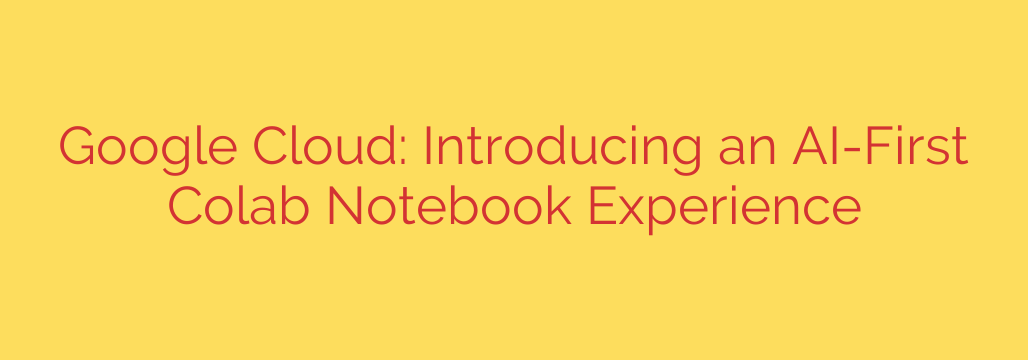
Revolutionize Your Data Science Workflow: Google Colab Introduces Powerful AI Coding Features
The world of data science and machine learning is about to get a major upgrade. Google Colaboratory, better known as Colab, the go-to platform for interactive coding and analysis, is integrating a suite of powerful generative AI features. This move is set to fundamentally change how developers, researchers, and data scientists write code, analyze data, and build models, making the entire process faster and more intuitive.
For years, Colab has been an essential tool for its ease of use and access to powerful computing resources. Now, it’s becoming an intelligent partner in your workflow, capable of understanding your goals and helping you achieve them with unprecedented efficiency.
What’s New? An AI-Powered Coding Assistant Inside Your Notebook
At the heart of this update is the integration of AI-powered assistance directly into the Colab notebook interface. This isn’t just simple autocomplete; it’s a comprehensive set of tools designed to streamline every step of the coding process.
Here are the key features transforming the Colab experience:
AI-Powered Code Generation: Imagine describing a task in plain English and watching the corresponding code appear instantly. With the new AI features, you can use natural language prompts to generate entire code blocks. Need to load a CSV file from Google Drive, clean the data by removing null values, and visualize the first five rows? Simply type your request, and the AI will write the Python code for you. This dramatically reduces the time spent on boilerplate code and searching for syntax.
Intelligent, Context-Aware Code Completion: Go beyond basic suggestions. The new AI understands the context of your entire notebook, including your previously written code and comments. As you type, it will offer smarter, multi-line completions that are far more relevant and useful than traditional autocomplete. This helps maintain your flow state and accelerates development.
An Integrated AI Chatbot for On-the-Fly Help: Stuck on a problem? Need to understand a complex piece of code? A new integrated chatbot assistant is available directly within Colab. You can ask questions about your code, request explanations for a specific function, get help with debugging, or even ask it to generate documentation. It’s like having an expert programmer available to help you 24/7.
The Technology Behind the Magic: Powered by Codey Models
These groundbreaking capabilities are driven by Google’s family of foundation models called Codey. Unlike general-purpose language models, Codey models have been specifically trained and fine-tuned on a massive dataset of high-quality code and documentation. This specialized training allows them to understand programming languages, coding logic, and development best practices with remarkable accuracy.
This ensures that the code generated is not only syntactically correct but also idiomatic and efficient, following conventions that experienced programmers would use.
What This Means for Developers and Data Scientists
The integration of AI into Colab is more than just a convenience; it represents a significant shift in how data-centric work is done.
Massive Productivity Gains: By automating repetitive and time-consuming tasks like writing boilerplate code, data cleaning scripts, and visualizations, these tools free you up to focus on higher-level strategic thinking. You can spend less time on the “how” and more time on the “what” and “why” of your analysis.
Lowering the Barrier to Entry: For students, aspiring data scientists, or professionals from other fields, these AI features make coding more accessible. If you know what you want to achieve but are unsure of the exact syntax, you can now translate your ideas directly into functional code, making the learning curve much gentler.
A More Seamless and Creative Workflow: The ability to generate, complete, and get explanations for code in a single, uninterrupted flow fosters a more creative and experimental environment. You can test hypotheses and explore datasets faster than ever before.
How to Get Started and Best Practices
These new AI features are beginning to roll out to users in the United States, starting with Colab’s paid subscribers. A broader release, including availability for the free tier, is planned for the future.
As you begin to incorporate these powerful tools into your projects, remember a key security tip: Always review AI-generated code before execution. While the models are highly advanced, it is your responsibility to verify the code for accuracy, efficiency, and security, especially when working with sensitive data or production environments. Treat the AI as a highly skilled assistant whose work always requires a final check.
This evolution of Google Colab marks a pivotal moment for interactive computing, promising to unlock new levels of productivity and innovation for the entire data science community.
Source: https://cloud.google.com/blog/products/ai-machine-learning/ai-first-colab-notebooks-in-bigquery-and-vertex-ai/








